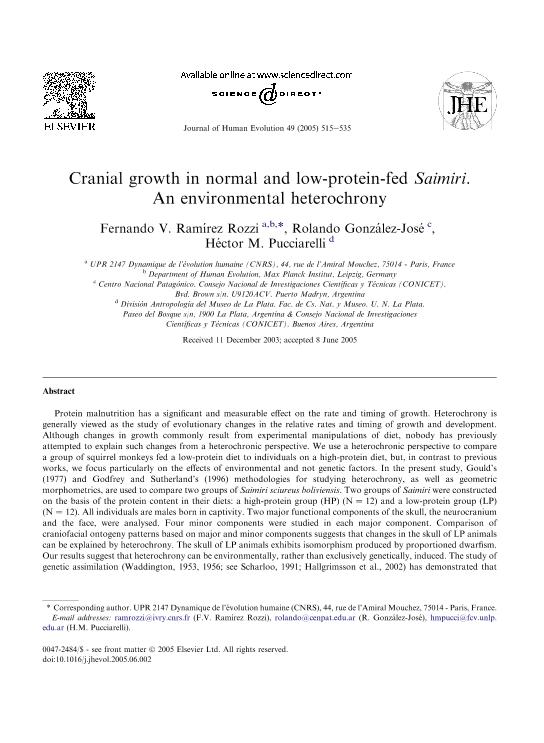Mostrar el registro sencillo del ítem
dc.contributor.author
Ramirez Rozzi, Fernando

dc.contributor.author
González José, Rolando

dc.contributor.author
Pucciarelli, Hector Mario

dc.date.available
2020-05-18T21:06:58Z
dc.date.issued
2005-10
dc.identifier.citation
Ramirez Rozzi, Fernando; González José, Rolando; Pucciarelli, Hector Mario; Cranial growth in normal and low-protein-fed Saimiri: An environmental heterochrony; Academic Press Ltd - Elsevier Science Ltd; Journal Of Human Evolution; 49; 4; 10-2005; 515-535
dc.identifier.issn
0047-2484
dc.identifier.uri
http://hdl.handle.net/11336/105443
dc.description.abstract
Protein malnutrition has a significant and measurable effect on the rate and timing of growth. Heterochrony is generally viewed as the study of evolutionary changes in the relative rates and timing of growth and development. Although changes in growth commonly result from experimental manipulations of diet, nobody has previously attempted to explain such changes from a heterochronic perspective. We use a heterochronic perspective to compare a group of squirrel monkeys fed a low-protein diet to individuals on a high-protein diet, but, in contrast to previous works, we focus particularly on the effects of environmental and not genetic factors. In the present study, Gould´s (1977) and Godfrey and Sutherland´s (1996) methodologies for studying heterochrony, as well as geometric morphometrics, are used to compare two groups of Saimiri sciureus boliviensis. Two groups of Saimiri were constructed on the basis of the protein content in their diets: a high-protein group (HP) (N = 12) and a low-protein group (LP) (N = 12). All individuals are males born in captivity. Two major functional components of the skull, the neurocranium and the face, were analysed. Four minor components were studied in each major component. Comparison of craniofacial ontogeny patterns based on major and minor components suggests that changes in the skull of LP animals can be explained by heterochrony. The skull of LP animals exhibits isomorphism produced by proportioned dwarfism. Our results suggest that heterochrony can be environmentally, rather than exclusively genetically, induced. The study of genetic assimilation (Waddington, 1953, 1956; see Scharloo, 1991; Hallgrimsson et al., 2002) has demonstrated that environmentally induced phenotypes often have a genetic basis, and thus parallel changes can be easily induced genetically. It is possible that proportioned dwarfism is far more common than currently appreciated.
dc.format
application/pdf
dc.language.iso
eng
dc.publisher
Academic Press Ltd - Elsevier Science Ltd

dc.rights
info:eu-repo/semantics/openAccess
dc.rights.uri
https://creativecommons.org/licenses/by-nc-sa/2.5/ar/
dc.subject.classification
Antropología, Etnología

dc.subject.classification
Sociología

dc.subject.classification
CIENCIAS SOCIALES

dc.title
Cranial growth in normal and low-protein-fed Saimiri: An environmental heterochrony
dc.type
info:eu-repo/semantics/article
dc.type
info:ar-repo/semantics/artículo
dc.type
info:eu-repo/semantics/publishedVersion
dc.date.updated
2020-05-15T15:56:11Z
dc.journal.volume
49
dc.journal.number
4
dc.journal.pagination
515-535
dc.journal.pais
Estados Unidos

dc.description.fil
Fil: Ramirez Rozzi, Fernando. Centre National de la Recherche Scientifique; Francia. Max-Planck-Institut für evolutionäre Anthropologie; Alemania
dc.description.fil
Fil: González José, Rolando. Consejo Nacional de Investigaciones Científicas y Técnicas. Centro Científico Tecnológico Conicet - Centro Nacional Patagónico; Argentina
dc.description.fil
Fil: Pucciarelli, Hector Mario. Universidad Nacional de La Plata. Facultad de Ciencias Naturales y Museo. Departamento Científico de Antropología; Argentina. Consejo Nacional de Investigaciones Científicas y Técnicas. Centro Científico Tecnológico Conicet - La Plata; Argentina
dc.journal.title
Journal Of Human Evolution

dc.relation.alternativeid
info:eu-repo/semantics/altIdentifier/doi/http://dx.doi.org/10.1016/j.jhevol.2005.06.002
dc.relation.alternativeid
info:eu-repo/semantics/altIdentifier/url/https://www.sciencedirect.com/science/article/abs/pii/S004724840500103X
Archivos asociados
